Zotac's Ion: The World's First mini-ITX Ion Board
by Anand Lal Shimpi on May 12, 2009 12:00 AM EST- Posted in
- GPUs
Putting It in Perspective: The Atom Takes on a Single-Core Pentium 4
When the Atom first appeared I immediately did my best to characterize its performance. Intel always referred to it as having the performance of a 90nm Pentium M but never really got as specific as I would like. In my subsequent testing I found that at 1.6GHz, Intel’s Atom performed like a 1.2GHz 90nm Pentium M (Dothan). If you had a Pentium M notebook back then, the comparison makes sense to you. If you didn’t, however, then you’d need another reference point.
I realized I had no idea how Atom compared to an old Pentium 4. To remedy the situation I dug up an old Dell based on a single-core, Northwood based (130nm) Pentium 4 running at 2.66GHz. These chips used a 533MHz FSB and had a 512KB on-die L2 cache. The system had an ATI Radeon X800 XT and 2GB of DDR memory. This Pentium 4 did not have Hyper-Threading, this was before HT made its official desktop debut.
For my first test I turned to Adobe Photoshop CS4:
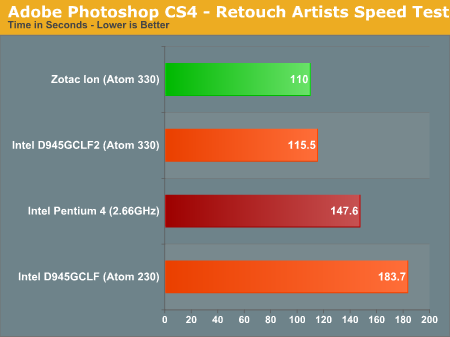
Wow. This is huge. Intel’s dual-core Atom 330 is 25% faster than the 2.66GHz Pentium 4. The advantage is all in the extra core though. If you look at the Atom 230 the Pentium 4 beats it by almost 20%.
Next I wanted to look at video encoding performance, one of the Pentium 4’s strongpoints. If you remember back then, even the Athlon 64 had difficulty competing with the P4’s encoding prowess. We’ll start with Windows Media Encoder:
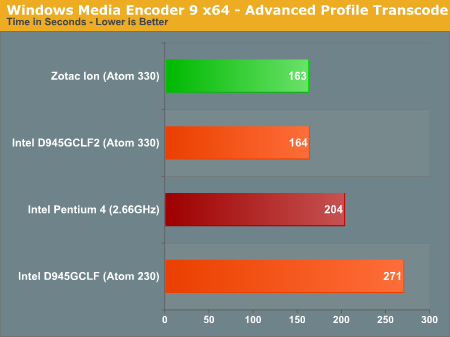
Again, the Atom 330 is faster than the Pentium 4 and again it’s due to the extra core. The Atom 230 is noticeably slower.
x264 encode performance is even more embarrassing for the Pentium 4; the Atom 330 is 62% faster in the first pass and 94% faster in the 2nd pass of the encode. The P4 system was 15% faster than the Atom 230 in the first pass and around 5% faster in the second pass.
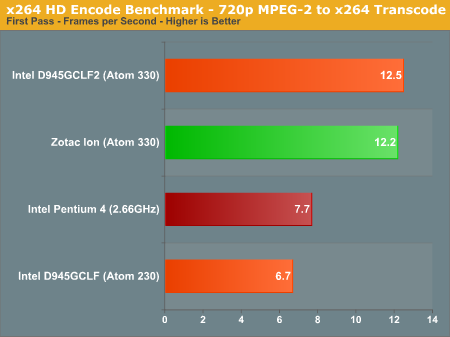
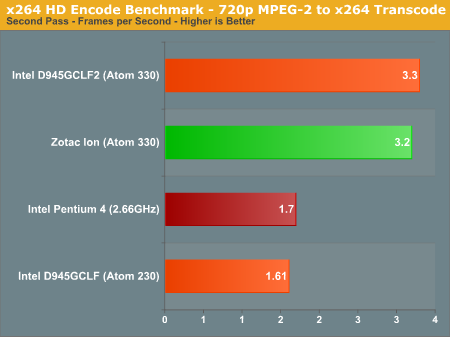
Next up was Cinebench. This is an interesting benchmark to look at because it offers both a single-threaded and multi-threaded benchmark. The Pentium 4 without Hyper-Threading can only execute a single thread, so the multi-threaded test can’t run. I’ve combined the meaningful results in a single chart:
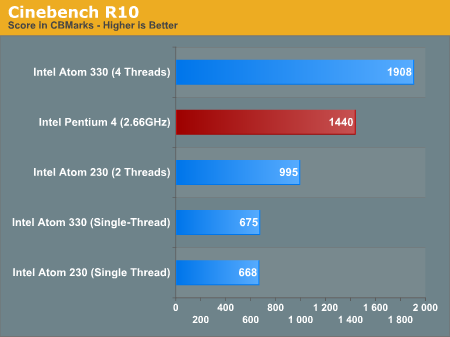
If we look at single-threaded performance, the Pentium 4 destroys the Atom - offering more than twice the performance of the svelte Atom core. Enable the multi-threaded render and the Atom 330 pulls ahead by 33%. This is the strength of the Atom; it’s clearly not faster than the Pentium 4 when working on a single thread, but exploit its ability to work on four threads simultaneously and it can actually be faster than a much larger, much more power hungry Pentium 4. This is a very important point to remember because despite losing to the Atom 330 in nearly all of the benchmarks, the Pentium 4 system it felt much faster than the Atom system in normal usage.
Simple things like opening up Control Panel or switching between windows felt faster on the old Pentium 4 system, which makes sense given that those tasks only spawn a single thread. In Cinebench we saw that the single-threaded performance of the old Pentium 4 was over twice as fast as the Atom - you tend to notice performance differences of that magnitude.
The final application test I ran was our WinRAR compression benchmark:
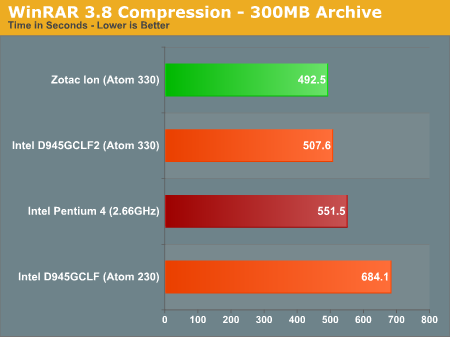
Once more, the Pentium 4 gets beat by the Atom 330 but turns the tables on the Atom 230. Even file compression is multi-threaded these days, and that is the Atom’s saving grace.
I wanted to know how well the GeForce 9300 could stand up against the old Dell’s Radeon X800 XT so I ran my WoW test on both systems. This is less of a CPU test and more of a CPU + GPU test obviously, but the results are interesting:
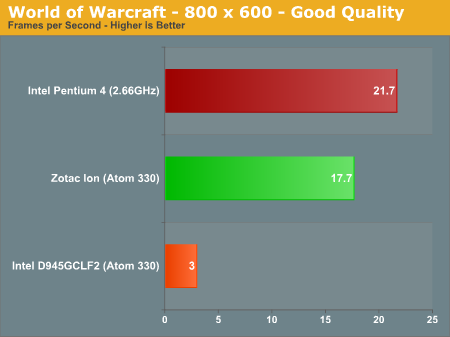
The Pentium 4 + X800 XT system is clearly faster, but not by as much as I expected. The advantage amounts to 22.5%, which is very noticeable, but close enough that if you had an even older system (or one with a lesser video card) you might not notice the performance difference between it and the Zotac Ion.
The last benchmark I ran comparing the Atom to a Pentium 4 was Futuremark’s Peacekeeper - a benchmark for measuring web browser performance. The benchmark is unaffected by internet connection and simply measures, once loaded, how fast your PC can work with various forms of commonly used javascript. I ran all of the Peacekeeper tests using Google Chrome:
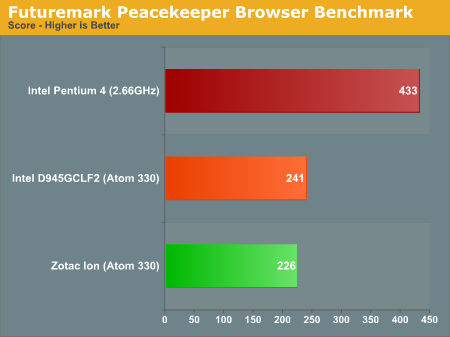
The Pentium 4 absolutely demolished the Atom here. Once again it’s almost twice as fast as the Atom 330. In a multi-threaded environment the Atom 330 can pull ahead, but in most typical day-to-day tasks the Pentium 4 is going to be a much faster solution.
Power efficiency is obviously where the Atom based Zotac Ion wins out. AMD and Intel both viewed the move to multiple cores as a performance and power efficiency win, and the results below help show that. Granted Atom is built on a 45nm process and we’re looking at a 130nm desktop Pentium 4 system, which is where much of the difference really comes from. But the results do show you that if you don’t need top bin performance you can build a very capable PC these days with significantly better power consumption characteristics.
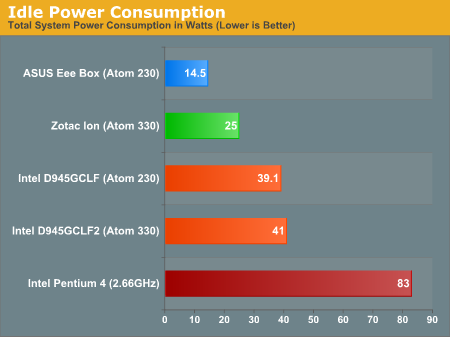
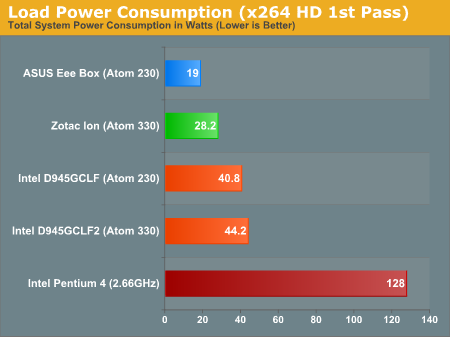
NVIDIA is forever arguing with me about how Atom and its Ion platform is a significant upgrade to PCs that are a few years old. My Pentium 4 results show that unfortunately, that’s not exactly the case. The Pentium 4 system I compared Zotac’s Ion to could never function as a modern-day HTPC and it won’t play Blu-ray discs. In those senses, Zotac’s Ion would be a tremendous upgrade. Even in multi-threaded CPU bound scenarios such as video encoding or 3D rendering, a dual-core Atom 330 is appreciably faster than the old Pentium 4 based Dell system. However, in normal web browsing and simply interacting with Windows, the Pentium 4 is significantly faster. The benchmarks show a nearly 2x performance advantage in single-threaded applications and I’d say they are accurately reflected in the usage experience.










93 Comments
View All Comments
bobvodka - Wednesday, May 13, 2009 - link
While I know it's only at the RC stage, it might be intresting to see how this plays with Win7, if only as a nod to the future and with regards to how it performs against XPlemon8h8ead - Wednesday, May 13, 2009 - link
Thanks for a good job in optimizing control over the environment. It is not easy to create apples-to-apples tests.I would have been interested in seeing the same H/W configurations running one of the popular Linux distros (E.g. Ubuntu). It has been my observation that the Linux kernel multithreads more efficiently than Windows but those were purely compute-bound applications that I was comparing and the benchmarks are 8 years old on very dated H/W platforms (obsolete). I realize that both Windows and Linux kernels have improved vastly since then.
Is your HTPC speced out here anywhere? Just curious.
sysdump - Wednesday, May 13, 2009 - link
I want to see HD H264 content decoded using CUDA! To see if it can handle non DXVA compatible videos.mvrx - Wednesday, May 13, 2009 - link
I've been using an Atom 330 system as a DD-WRT router.. cost me only $150 and is probably 15x faster than any Dlink or linksys on the market.. People really need to pay attention to this possibility.mindless1 - Wednesday, May 13, 2009 - link
Presumably you're comparing against Dlink and Linksys consumer grade routers, that are meant for light use. In such a scenario why would it need to be 15X faster and had you done latency tests that quantify the difference? Checking latency on a router running DD-WRT I find the router latency insignificant compared to the rest of the nodes along a typical connection, and that when the router is even doing QOS concurrent to P2P transfers.I'd think a board like this to be quite overkill for mere routing, it might be nice though to have a few more features possible like DNS caching, web proxy, advanced firewall rules, web/mail server.
JoKeRr - Wednesday, May 13, 2009 - link
For $80 with 3 SATA ports and add in some ram and 3 hard disks, this will make a decent NAS file server with linux installed.I use a PS3 in the living room, it used to be a old mac mini. Right now I definitely miss the iPhone remote with iTune in the mac mini. PS3 is great for movies, but for not so with web content. I use PS3 media server to stream movies from my PC to the PS3, it also performs transcoding on the content that PS3 doesn't recognize (mkv). My desktop is P4 3.0C overclocked to 3.5GHz, and it has no problem transcoding mkv movies in 720p resolution (max bit rate I saw was around 15Mbps), I would really like to know how the dual core atom performs on the transcoding front with PS3 media server. If it works well, it will be a very nice compliment to the PS3 system.
Thank you!
NullSubroutine - Saturday, May 16, 2009 - link
I thought I'd like to throw out that that with MKV files you can mux them (like with tsMuxer) to MT2S files which can then be renamed to MP4 to play on PS3.Muxing takes less than a minute usually and doesn't convert the video just takes it out of the MKV container file.
It may be easier to do this with your files than have them transcode on the fly.
ViRGE - Tuesday, May 12, 2009 - link
If only it had component out. The HDMI port is nice, but I had a RP-CRT; I'd love to replace my HTPC box with something like this, but the lack of component out is a killer.moozoo - Tuesday, May 12, 2009 - link
I believe the ION platform supports CUDA.Please run some CUDA benchmarks and those H264 video encodings using BadaBOOM on this motherboard.
The ION chipset (MCP79) has very low latency between the GPU and the main memory. This makes it possible to perform audio functions on the GPU.
See http://forums.nvidia.com/index.php?showtopic=92290">http://forums.nvidia.com/index.php?showtopic=92290
JarredWalton - Tuesday, May 12, 2009 - link
From the conclusion:"I did try some CUDA applications on the Zotac Ion board and they were definitely faster than using the CPU alone. While our x264 test managed around 12 fps on the Zotac Ion, using Badaboom I was able to encode at just under 20 fps."